note to sensitive readers: this blog contains pictures of flesh wounds
My daughter’s love for wildlife showed up long before she had the words to describe it. While other little ones were chasing bubbles or digging in sandboxes, mine was rescuing earthworms after rainstorms. I’ll never forget watching three-year-old Karen carefully relocate night crawlers from the pavement to the grass with the seriousness of a tiny field biologist. Looking back, that was the official start of her wildlife rescue career, though at the time, we just thought she was unusually compassionate toward anything that crawled.
By fourteen, she was a state licensed wildlife rehabilitator, bottle-feeding orphaned mammals and cleaning wounds on injured birds with a level of maturity most adults can only admire. One day after returning from the vet with one of her patients, she placed the carrier down, looked up, and said in her calm, matter-of-fact way: “I can’t spend my life going to the vet. I need to be the vet.” And just like that, her world shifted, her purpose snapped into place, and her path was set.
One story from her wildlife-filled life always comes back to me around Thanksgiving. It began on one of her late drives home from her animal hospital, a route that carried her through the largest forest preserve in Illinois. She always said the forest felt like a daily blessing bookending her workdays: quiet movement, steady, and full of life watching from the shadows.
That evening, she saw a large turkey standing motionless near the roadside, fresh blood on his chest. Karen pulled over without a second thought. The turkey staggered into the woods toward a parked pickup, and as she followed, she heard men’s voices approaching. Not wanting to be caught alone in that situation, she hurried toward the turkey who had hopped onto the side of the truck. Inside the truck bed she saw the body of a female turkey, almost certainly poached. As the voices grew closer, she scooped up the dazed, injured male and ran back to her SUV, grateful that she always kept a carrier, blankets, gloves, and supplies in the vehicle for situations exactly like this.
Once home, she cleaned the wound with dilute betadine. The bullet had grazed his chest, leaving a large flesh wound but sparing anything vital. There was no skin available to do a skin graft; the wound would have to heal on its own, and it was Karen’s job to prevent infection during this long, slow process.
She had just begun learning about the healing properties of Manuka honey and decided to try it. She applied it several times a day, and every evening she shared updates that sounded a little like she was witnessing a small miracle: less inflammation, health, pink tissue, steady healing. The honey protected the wound, kept it moist, and seemed to do exactly what the research promised.
During this critical healing time, she took the turkey to her hospital. The turkey stayed in the wildlife ward of the hospital until his wounds scabbed over, and the risk of infection was minimized.
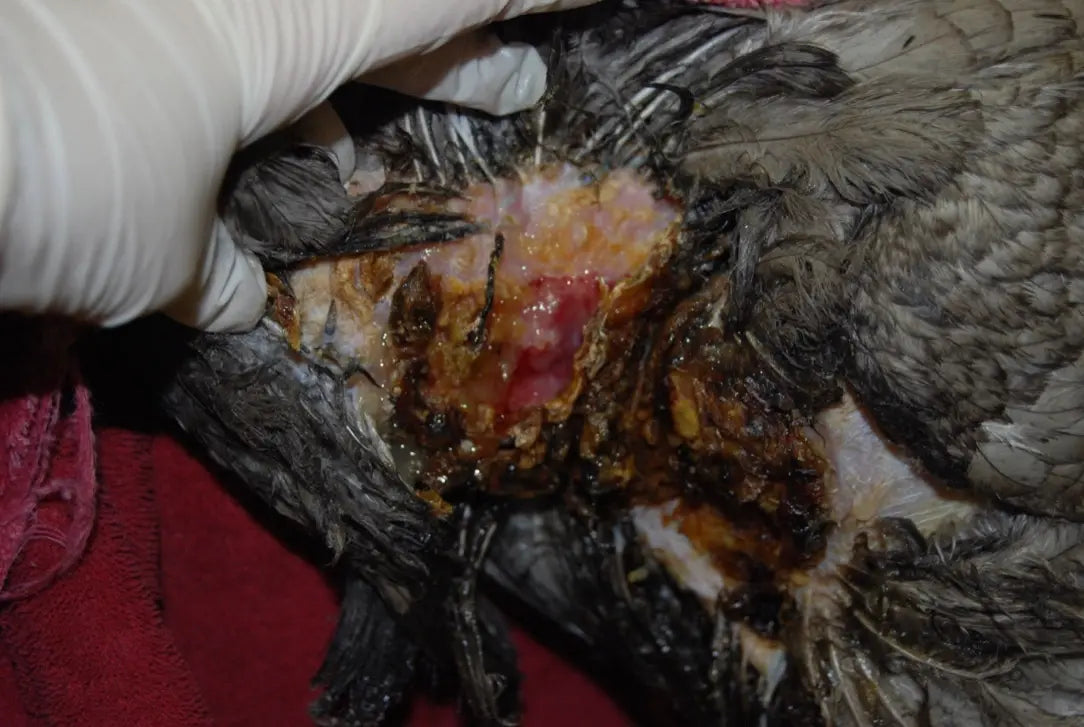

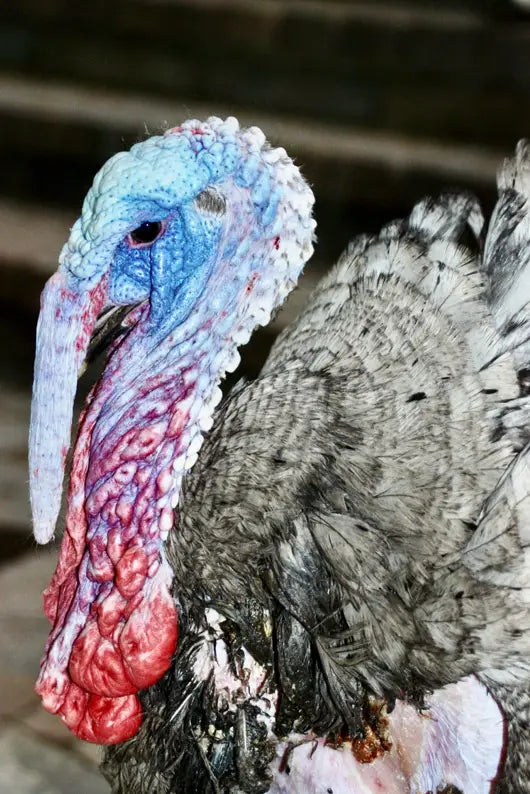
This photo highlights Tom’s beautiful facial features, and also his healing wound.
Turkeys wear their emotions on their faces, literally. Male turkeys are called toms. Karen explains the bare skin across a tom’s head is filled with reactive, vascular tissue that works much like erectile tissue, swelling and shifting colors in moments. When he’s excited or curious, blood rushes into these structures, turning subtle pinks into vivid reds, blues, and whites. The snood is the long, fleshy appendage that drapes over the beak; the wattle is the loose skin that hangs beneath the chin and neck; and caruncles are the small, knobby bumps scattered across the head and upper neck. Each of these structures can enlarge dramatically, becoming a bright, expressive signal to other turkeys (and beloved veterinarians, as we’ll come to find out).


Once it was safe for him to be outside (and not become a victim of “fly strike,” where flies lay eggs on open wounds), Karen brought him home to recover. The turkey (soon to be named Tom) settled into her small, heated barn.
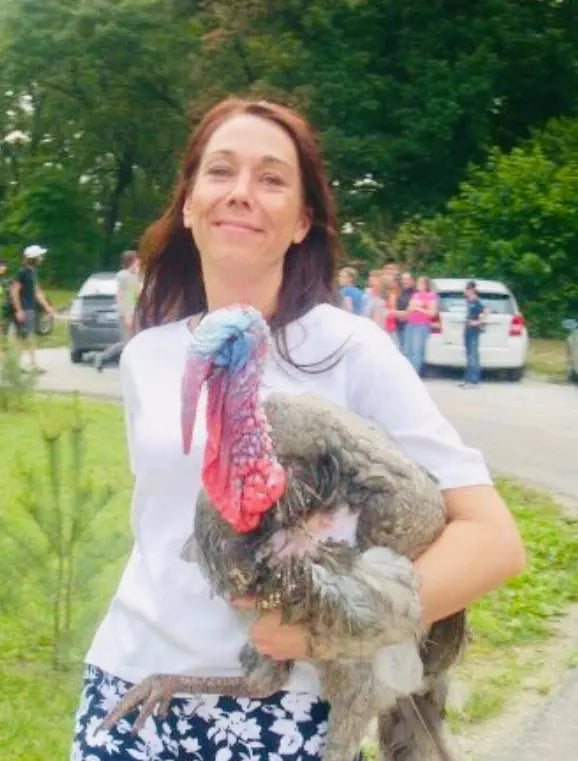
Tom, going to the barn
Over time, it became clear that Tom was developing a strong attachment to his doctor. Karen’s husband noticed this new romantic development before Karen did. He told her, only half-joking, “I think this turkey is trying to replace me. He’s absolutely courting you.” And he wasn’t wrong. Her husband was not the least interested in a showdown with a turkey who was after his wife! This was a most interesting picture to watch unfold.
And he was right. Jim, my husband, and I witnessed this love triangle firsthand.

Tom, waiting for Karen to come outside
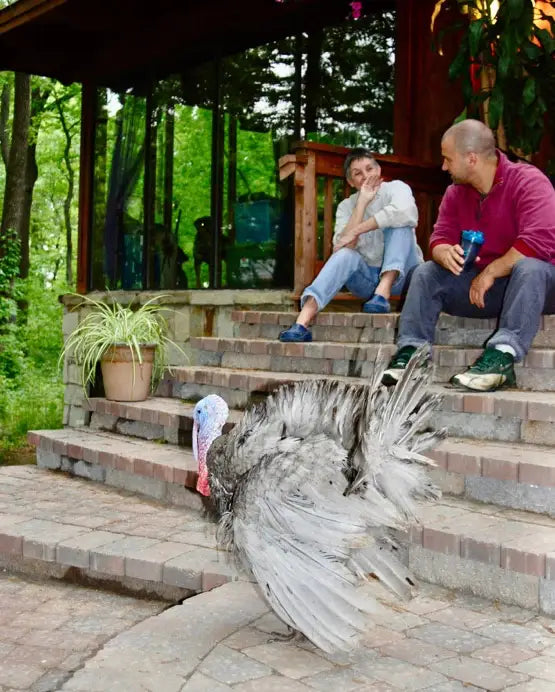
Tom, the neighbor, and I chat on the front steps.
Tom followed Karen everywhere she went. He strutted behind her like an overconfident suitor. He knocked on the front windows demanding entry. He walked her down the lane every morning as she left for work and raced to meet her when she returned in the evening. And when her husband dared to approach her? There is nothing quite like watching a 20-pound turkey glare at a full-grown man for daring to stand next to “his” woman. He strutted, he preened, he stared down her husband, with the subtlety of a soap-opera villain. Her husband, who had tolerated many unusual wildlife situations over the years, simply and firmly said, “No way! This has to stop!” My friends, this was the best comedy we’d seen in a long time!
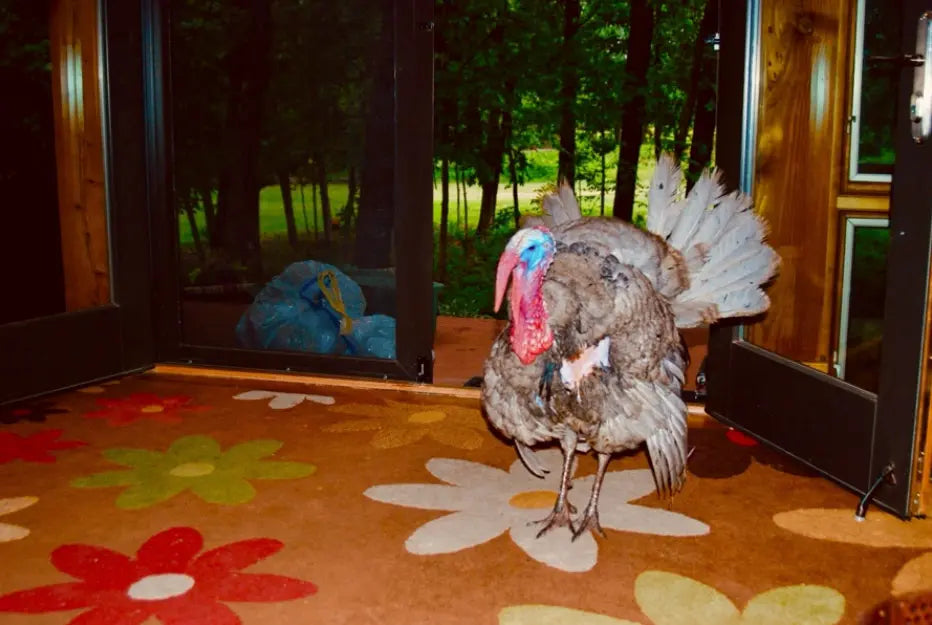
Tom would gladly come inside to hang out with our family if we left the front door open.

Tom, waiting for Karen to get home from work at the end of their driveway
It became clear that once Tom was healed, he needed to be released somewhere safe, somewhere without easy access to people, where he could find a turkey wife. But taking him back to the preserve where he’d been shot was not an option. So Karen found a different forest preserve, one with plenty of space and, hopefully, a suitable turkey companion. When she opened the carrier door, Tom stepped out strong, healed, and ready to return to the life he was meant to live.
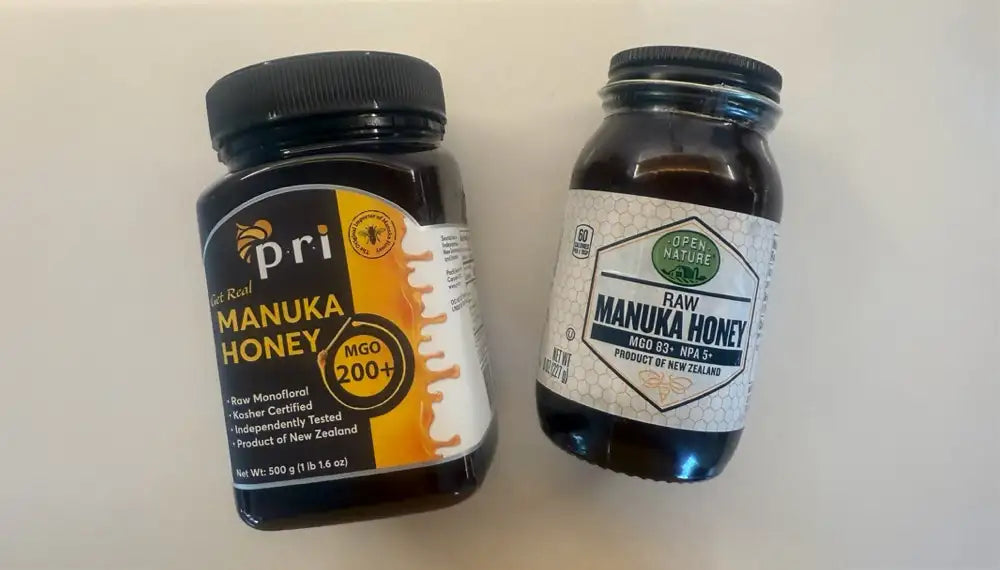
Manuka honey played a remarkable role in his recovery. Harvested from the Manuka bush in New Zealand, it’s uniquely effective against bacteria—even antibiotic-resistant strains like MRSA. It creates a wound environment where harmful microbes simply can’t thrive, all while supporting tissue repair and reducing inflammation. We’ve seen its impact on people in our family, too; my niece’s severe lip injury healed beautifully with its help.
But Manuka honey also reminds me how essential bees are, and how vulnerable they’ve become. Their well-being is tied to countless small miracles like Tom’s.
Tom the Turkey remains one of our favorite family stories. His rescue, his healing, his unmistakable personality, and yes, his brief infatuation with his doctor—all of it left its mark on us. I hope his story brings a bit of warmth to your Thanksgiving, the way it always does to ours.
Wishing you a memorable Thanksgiving,



